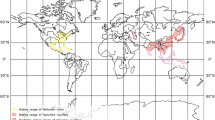Abstract
Sanchi (Panax notoginseng) root has been widely used as traditional herb to stanch blood, disperse gore and reduce pain in China for centuries. However, the nutritional information about its seed was unknown. Sanchi seeds obtained from Yunnan Province were analyzed for their nutritional composition, fatty acid, amino acid profile and sugar contents. Sanchi seeds were abundant in fats (46.35 %) and proteins (23.90 %). Notably, seven fatty acid compositions were determined and abundant in unsaturated fatty acid (99.56 %), containing 95.71 % oleic acid. Sanchi seed proteins were rich in glutenin, globulin and albumin (28.63, 27.83 and 26.81 %, respectively). Sanchi seed contain 17 kinds of amino acids, of which nine were essential amino acids, accounting for 41.30 %. These nutritional compositions indicate that Sanchi seed has the potentiality to be exploited as human edible oil, industrial use, new medicine or healthcare products for diabetes patients due to low sugar content.
Similar content being viewed by others
References
Birk Y, Peri I (1980) Saponin. In: Liener IE (ed) Toxic constituents of plant foodstuffs, 2nd edn, vol 1. Academic Press, New York, pp 161–182
Cui X, Wang C, Li W (1993) Biological characteristics of the Panax notoginseng seed. Chin Herb Med 16:3–4
FAO/WHO Ad Hoc Expert Committee (1973) Energy and protein requirements. FAO Nutr Meet Rep Ser 52:40–73
FAO/WHO/UNU Expert Consultation (1985) Energy and protein requirements. WHO Tech Rep Ser 724:120–126
Fen L, Pan X, Sun Z (2008) The notoginseng pharmacological effects of progress. China Pharm 11:1185–1187
Gao F (2006) The guidance of plant physiology experiments. Higher Education Press, Beijing
Gillingham LG, Harris-Janz S, Jones PJH (2011) Dietary monounsaturated fatty acids are protective against metabolic syndrome and cardiovascular disease risk factors. Lipids 46:209–228
Guo HB, Cui XM, An N, Cai GP (2010) Sanchi ginseng (Panax notoginseng (Burkill) F. H. Chen) in China: distribution, cultivation and variations. Genet Resour Crop Evol 57:453–460
Jone Q, Earle FR (1966) Chemical analysis of seeds II: oil and protein content of 759 species. Econ Bot 20:127–155
Ma S, Yu H (1989) The Araliaceae medicinal plant resources. Chin Herb Med 11:43
Rocca AS, Lagreca J, Kalitsky J, Brubaker PL (2001) Monounsaturated fatty acid diets improve glycemic tolerance through increased secretion of glucagon-like peptide-1. Endocrinology 142:1148–1155
Shang CB, Lowry PP II (2007) Araliaceae in flora of China, 13th edn. Science Press, Beijing, pp 435–491
Song Z, Ji C (1995) Modern analytical instruments and test methods. Northwest University Press, Xi’an
Stark AH, Madar Z (2002) Olive oil as a functional food: epidemiology and nutritional approaches. Nutr Rev 60:170–176
Sun S, Wang CZ, Tong R, Li XL, Fishbein A, Wang Q, He TC, Du W, Yuan CS (2010) Effects of steaming the root of Panax notoginseng on chemical composition and anticancer activities. Food Chem 118:307–314
Wen J, Zimmer EA (1996) Phylogeny and biogeography of Panax L. (the Ginseng genus, Araliaceae): inferences from its sequences of nuclear ribosomal DNA. Mol Phylogenet Evol 6:167–177
Xia Q (1997) Protein chemistry research and progress. Science Press, Beijing
Acknowledgments
This work was supported by Tianjin TASLY Modern TCM Resources Co., Ltd. We thank Dr. Rang Cao and Dr. Hui Duan for their technical help, Dr. Li Yang for providing the P. notoginseng seeds and Professor Wenlong Xu for revision suggestion.
Author information
Authors and Affiliations
Corresponding author
Additional information
Pengguo Xia and Hongbo Guo have contributed equally to this work.
Rights and permissions
About this article
Cite this article
Xia, P., Guo, H., Liang, Z. et al. Nutritional composition of Sanchi (Panax notoginseng) seed and its potential for industrial use. Genet Resour Crop Evol 61, 663–667 (2014). https://doi.org/10.1007/s10722-014-0082-9
Received:
Accepted:
Published:
Issue Date:
DOI: https://doi.org/10.1007/s10722-014-0082-9




